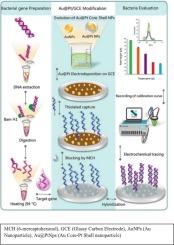双金属核壳纳米结构Au@Pt作为脑脊液中单核增生李斯特菌超灵敏检测的有效电化学介质
IF 4.9
Q1 CHEMISTRY, ANALYTICAL
引用次数: 0
摘要
与单核细胞增生李斯特菌有关的细菌感染可导致严重的病理状况,如人类脑膜炎和脑膜脑炎。因此,检测李斯特菌颗粒和副产物是一个非常重要的问题,在临床设置。纳米结构以其独特的物理化学性质在不同领域得到了广泛的应用。具体来说,双金属纳米结构已被用于智能生物传感器的开发。在本研究中,利用双金属纳米结构建立了一个简单高效的平台来创建单核细胞增生李斯特菌的诊断系统。合成了Au@Pt核壳结构,并电沉积了玻碳电极(GCE)。将靶向hly基因的24-mer硫代单链探针固定在Au@Pt修饰的GCE上,与目标序列杂交。然后用方波伏安法(SWV)进行电化学测量,以保证杂交反应的进行。在真实脑脊液(CSF)样品中使用标准添加验证了生物传感器的效率,以评估生物传感器检测生物体液中细菌基因组学的特异性。实验结果表明,所设计的生物传感器能够检测目标基因组序列。该平台能够检测到5 ~ 60亚摩尔的目标,并被证明是一个实用的检测极限。结果表明,该平台具有较高的灵敏度和特异性,可用于生物体液中靶基因序列的检测。本文章由计算机程序翻译,如有差异,请以英文原文为准。

Bimetallic core-shell nano-architecture of Au@Pt as an effective electrochemical mediator for ultrasensitive detection of Listeria monocytogenes in cerebrospinal fluid
Bacterial infections related to Listeria monocytogenes can lead to serious pathological conditions such as meningitis and meningoencephalitis in humans. Therefore, the detection of Listeria particles and byproducts is a very important issue in clinical settings. Nanostructures have been broadly utilized in different areas because of their unique physicochemical properties. Specifically, bimetallic nanostructures have been employed in the development of smart biosensor types. In the study, a simple and efficient platform utilizing bimetallic nanostructures was developed to create a diagnostic system for Listeria monocytogenes. The Au@Pt core-shell structure was synthesized and electrodeposited the glassy carbon electrode (GCE). A 24-mer thiolated single-strand probe, targeting the hly gene, was immobilized on the Au@Pt modified GCE to hybridize with the target sequence. Then, the electrochemical measurement with square wave voltammetry (SWV) technique was done to ensure the hybridization reaction. The biosensor's efficiency was validated using standard addition in real cerebrospinal fluid (CSF) samples, to assess biosensor specificity in the detection of bacterial genomics in biofluids. The obtained results indicate that the designed biosensor was able to detect the target genomic sequences. This platform was capable of detecting targets in 5 to 60 attomolar and was proved as a practical detection limit. It is suggested that the designed platform with high sensitivity and specificity for the detection of target gene sequences in biofluids.
求助全文
通过发布文献求助,成功后即可免费获取论文全文。
去求助
来源期刊

Sensing and Bio-Sensing Research
Engineering-Electrical and Electronic Engineering
CiteScore
10.70
自引率
3.80%
发文量
68
审稿时长
87 days
期刊介绍:
Sensing and Bio-Sensing Research is an open access journal dedicated to the research, design, development, and application of bio-sensing and sensing technologies. The editors will accept research papers, reviews, field trials, and validation studies that are of significant relevance. These submissions should describe new concepts, enhance understanding of the field, or offer insights into the practical application, manufacturing, and commercialization of bio-sensing and sensing technologies.
The journal covers a wide range of topics, including sensing principles and mechanisms, new materials development for transducers and recognition components, fabrication technology, and various types of sensors such as optical, electrochemical, mass-sensitive, gas, biosensors, and more. It also includes environmental, process control, and biomedical applications, signal processing, chemometrics, optoelectronic, mechanical, thermal, and magnetic sensors, as well as interface electronics. Additionally, it covers sensor systems and applications, µTAS (Micro Total Analysis Systems), development of solid-state devices for transducing physical signals, and analytical devices incorporating biological materials.
 求助内容:
求助内容: 应助结果提醒方式:
应助结果提醒方式:


